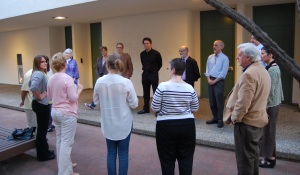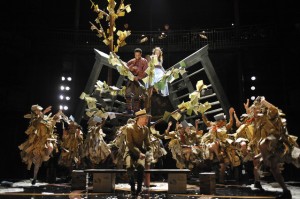Scripps College hosted the “21st Century Shakespeare” faculty workshop this past weekend, which brought a group of Shakespeareans working at liberal arts colleges together to share tools, strategies, and ideas for teaching the Bard’s works in our current cultural context (see our Workshop page for the talks).
We were joined by two outstanding digital Shakespeareans, Michael Best, of Internet Shakespeare Editions, and Peter Donaldson, of the Shakespeare Electronic Archive. As I listened over the course of the weekend, I was struck by two things: the many exhortations to fearlessness and a palpable enthusiasm for innovation in teaching.
Run toward what you fear 
Whether is was approaching Elizabethan music and dance, mounting a modern performance on a shoestring budget, engaging with global adaptations of Shakespeare, or understanding the range of digital textual resources, we heard some form of a call to fearlessness repeatedly this weekend. Scholars are a, well, scholarly bunch. We’ve been trained to devote a depth of time and thought to our objects of study, to master long histories of readership, reception, and cultural production. Generally this is a good thing – we are dedicated to the labor of our craft and to due diligence. But it can lead to something like academic trepidation – a fear that I cannot possibly begin to talk about that madigral or recipe without many hours of careful study. I might, after all, get it WRONG. Instead of fearing the unknown, or under-known, what I heard my colleagues saying this weekend was that we should feel authorized to let go, to play with the possibilities that historical artifacts afford us.
For Amy Hayes this manifests in her work to bring a “living Shakespeare” (rather than the right Shakespeare) into the lives of high school students through the DePauw “Will Power: Shakespeare in the Schools” program. A similar note was struck by Denise Walen’s suggestion that teaching students to read Shakespearean texts as scripts (rather than authoritative, sacred texts) enables a more embodied engagement of Elizabethan drama. She had us up and on the green, reciting a short excerpt while changing direction every time we “ran into” the punctuation. I can say that I came away with a new appreciation for both the pacing of Shakespearean language and the power of embodied experience. Such fears assume that there is a way to get any cultural history of the early modern period right, a positivistic stance that most of us these days eschew in our scholarship. Nevertheless, it haunts our teaching.
We were encouraged by Leslie Dunn to brave past the uncertainties of the dances and songs that are marked in so many of Shakespeare’s texts in order to find ways to bring the possible song, the possible dance into our teaching. We had seen such bravery in action.
As part of our grant we each had the opportunity to see the Royal Shakespeare Company’s 5 play run in New York last summer. Their production of The Winter’s Tale, with its bizarre, almost tribal, and surely ahistorical dances was an absolute delight.
At one point this weekend, Peter Donaldson suggested that a certain degree of irreverence is critical to the classroom and to education generally. He was particularly gleeful about Asian appropriations of Shakespeare and their willingness to mashup, re-use, and refigure Shakespearean texts.

The take away: jump in, preferably feet first. Rather than shutting ourselves up in the cloisters of long studied contexts, we should feel free to bring a range of lived and living contexts to bear on our readings and performances of Shakespearean texts.
Variants as a path to fearlessness in students
While we indulged in the “wild and wacky” and practiced being unafraid of the unknown, we also stayed true to the textual scholarly modes that are the bread and butter of our craft. Textual cruxes were on full display as pedagogical tools over the weekend. Timothy Billings walked us through a great set of exercises that drew on digital editions to teach students about the editing process, the slipperiness of the idea of The Text, and the playfulness of variation. Michael Best offered us a first glimpse of an animation under development for ISE that allows for an elegant switch between variants. In both cases, the foregrounding of variation, of the problems like those of the “bad quarto” and “authoritative editions,” gave us another opportunity to think about fearlessness in Shakespeare pedagogy. Over and over again people spoke of breaking down the produced authority of the major editions (or even the historical editions – it is certainly possible to fetishize the Folio or Q2), and of giving students both reasons and the confidence to question editorial choices. We were looking for ways to encourage students to see Shakespeare as an artist at work rather than his work as an ossified set of texts.
The faculty group had come together in order to share ideas, resources, and to teach one another about new tools and techniques. But it also became clear that making the issues familiar to textual scholarship “alive” for students is as much about professorial enthusiasm as possible digital tools or new contexts and practice. Yes, digital editions made it easier to make editions “talk” to one another in a single page – allowing for rapid comparison and, consequently, the ability to see Shakespeare’s works as a process of revisions. Animation and visualization are tools that we can and should deploy. Yes, embodied practice brought new insights. But it was also clear that the passion of the teacher, the willingness to put in the time to make the argument clear and to lay the groundwork for understanding, is absolutely essential. It was evident that this is a passion with a long, slow burn.
As the most junior faculty member in the room, I was struck by the time and thoughtfulness evident in each person’s description of his/her teaching. In my second year on the tenure-track I can say that I have intimate knowledge of the labor involved in new preps – I’ve yet to repeat a course here at Scripps. I do not have personal knowledge of the long evolution of a class taught many times – of the years of thinking and refining that go into great teaching. Such dedication and engagement was on full display this weekend, however. I found myself humbled and inspired by the thoughtfulness, the pedagogical generosity, and fearlessness of my colleagues.
We closed our first day with an affirmation exercise that Amy Hayes does with her performance students. I had three students who participated in the workshop this weekend and they took part in the exercise as well. A synthetic paraphrase of two of their affirmations might read like this: we reaffirm the commitment of good teachers to exploring new technologies and techniques to become great teachers. Amen.

